Food Safety and System Thinking in Public Health - Deakin University
VerifiedAdded on 2022/11/23
|11
|2591
|117
Report
AI Summary
This report addresses food safety and food security issues in Australia using a system thinking approach. It begins by outlining the background of food insecurity in Australia, highlighting the challenges related to food accessibility, affordability, and distribution. The report identifies the leverage p...
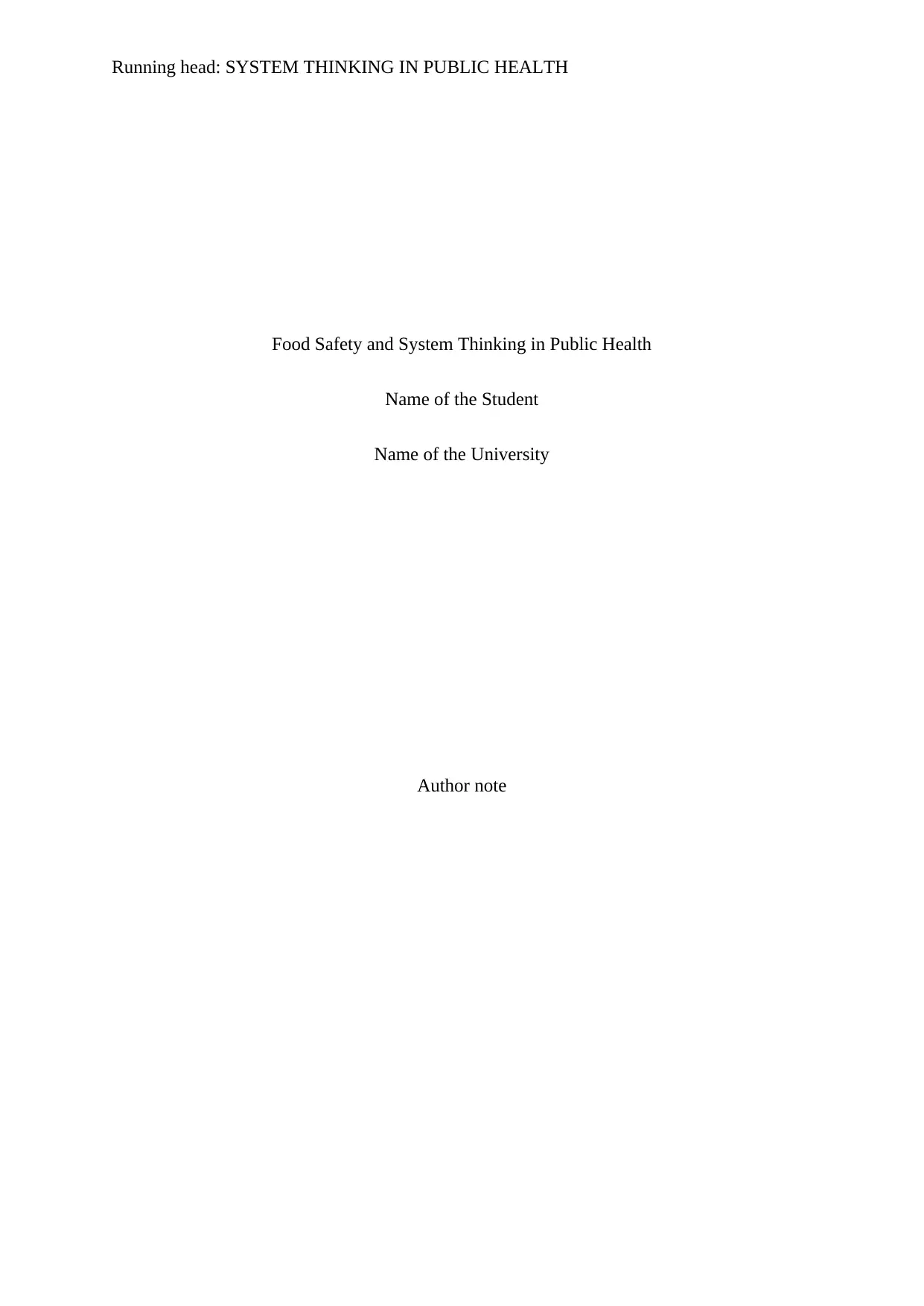
Running head: SYSTEM THINKING IN PUBLIC HEALTH
Food Safety and System Thinking in Public Health
Name of the Student
Name of the University
Author note
Food Safety and System Thinking in Public Health
Name of the Student
Name of the University
Author note
Paraphrase This Document
Need a fresh take? Get an instant paraphrase of this document with our AI Paraphraser
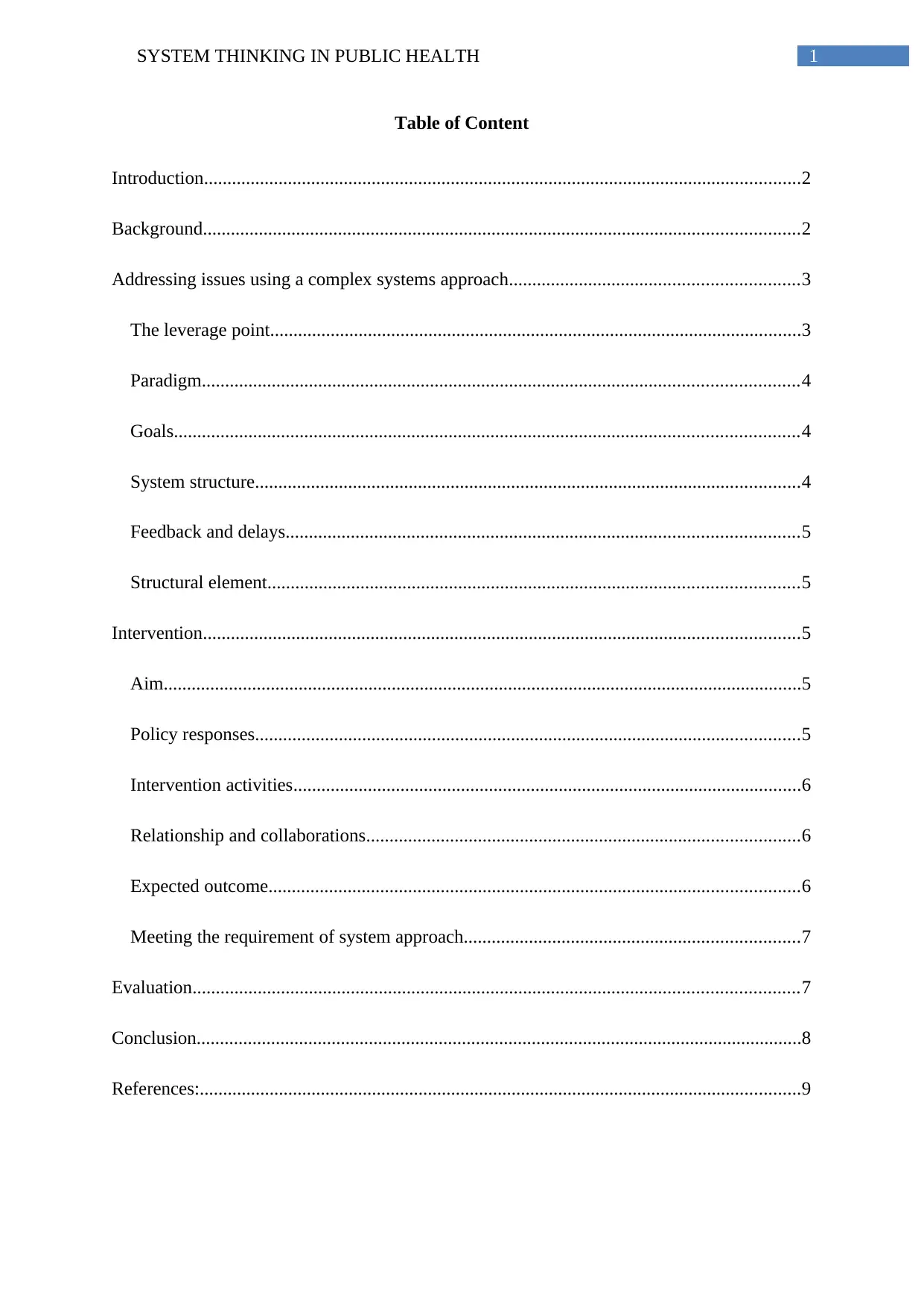
1SYSTEM THINKING IN PUBLIC HEALTH
Table of Content
Introduction................................................................................................................................2
Background................................................................................................................................2
Addressing issues using a complex systems approach..............................................................3
The leverage point..................................................................................................................3
Paradigm................................................................................................................................4
Goals......................................................................................................................................4
System structure.....................................................................................................................4
Feedback and delays..............................................................................................................5
Structural element..................................................................................................................5
Intervention................................................................................................................................5
Aim.........................................................................................................................................5
Policy responses.....................................................................................................................5
Intervention activities.............................................................................................................6
Relationship and collaborations.............................................................................................6
Expected outcome..................................................................................................................6
Meeting the requirement of system approach........................................................................7
Evaluation..................................................................................................................................7
Conclusion..................................................................................................................................8
References:.................................................................................................................................9
Table of Content
Introduction................................................................................................................................2
Background................................................................................................................................2
Addressing issues using a complex systems approach..............................................................3
The leverage point..................................................................................................................3
Paradigm................................................................................................................................4
Goals......................................................................................................................................4
System structure.....................................................................................................................4
Feedback and delays..............................................................................................................5
Structural element..................................................................................................................5
Intervention................................................................................................................................5
Aim.........................................................................................................................................5
Policy responses.....................................................................................................................5
Intervention activities.............................................................................................................6
Relationship and collaborations.............................................................................................6
Expected outcome..................................................................................................................6
Meeting the requirement of system approach........................................................................7
Evaluation..................................................................................................................................7
Conclusion..................................................................................................................................8
References:.................................................................................................................................9
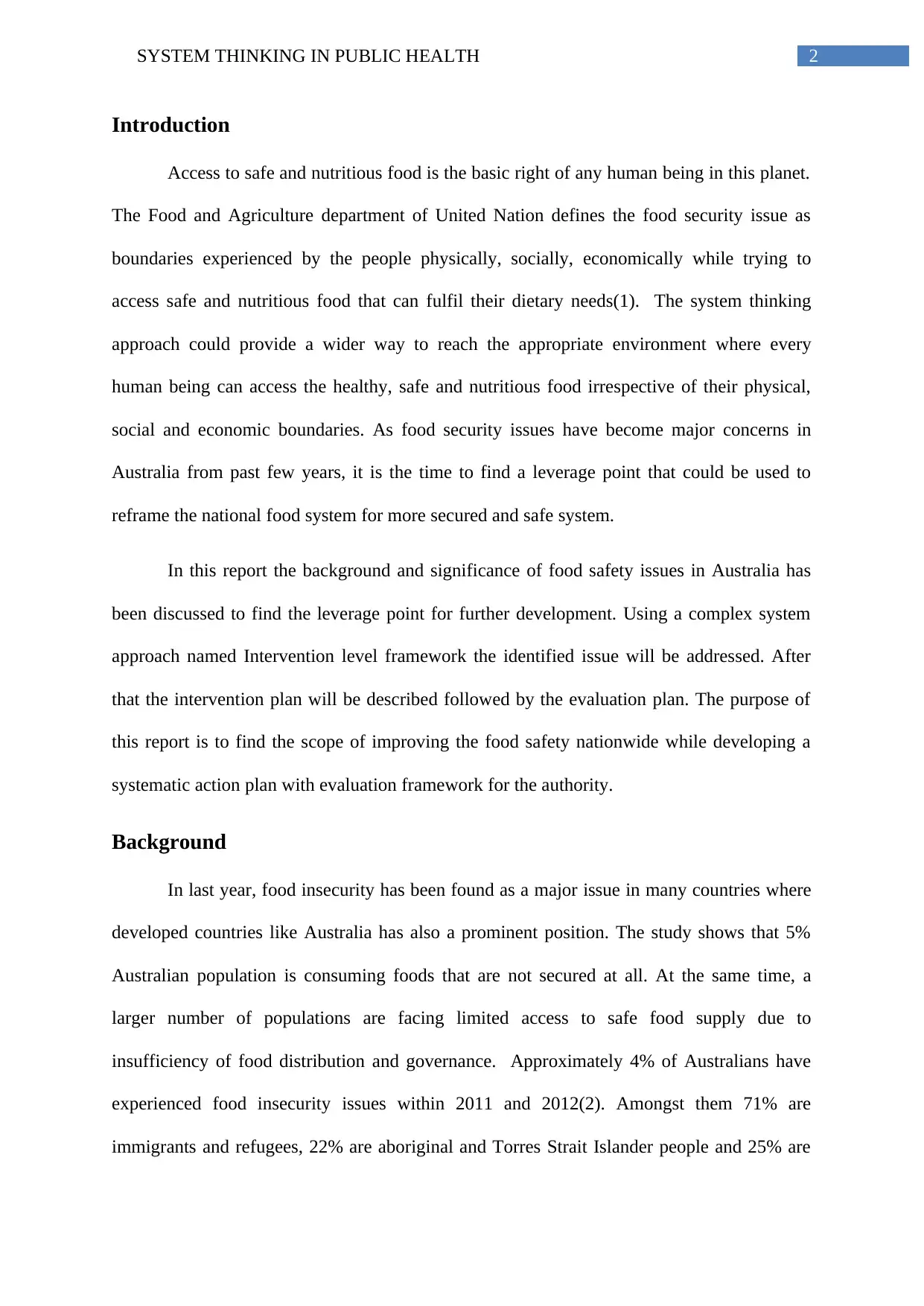
2SYSTEM THINKING IN PUBLIC HEALTH
Introduction
Access to safe and nutritious food is the basic right of any human being in this planet.
The Food and Agriculture department of United Nation defines the food security issue as
boundaries experienced by the people physically, socially, economically while trying to
access safe and nutritious food that can fulfil their dietary needs(1). The system thinking
approach could provide a wider way to reach the appropriate environment where every
human being can access the healthy, safe and nutritious food irrespective of their physical,
social and economic boundaries. As food security issues have become major concerns in
Australia from past few years, it is the time to find a leverage point that could be used to
reframe the national food system for more secured and safe system.
In this report the background and significance of food safety issues in Australia has
been discussed to find the leverage point for further development. Using a complex system
approach named Intervention level framework the identified issue will be addressed. After
that the intervention plan will be described followed by the evaluation plan. The purpose of
this report is to find the scope of improving the food safety nationwide while developing a
systematic action plan with evaluation framework for the authority.
Background
In last year, food insecurity has been found as a major issue in many countries where
developed countries like Australia has also a prominent position. The study shows that 5%
Australian population is consuming foods that are not secured at all. At the same time, a
larger number of populations are facing limited access to safe food supply due to
insufficiency of food distribution and governance. Approximately 4% of Australians have
experienced food insecurity issues within 2011 and 2012(2). Amongst them 71% are
immigrants and refugees, 22% are aboriginal and Torres Strait Islander people and 25% are
Introduction
Access to safe and nutritious food is the basic right of any human being in this planet.
The Food and Agriculture department of United Nation defines the food security issue as
boundaries experienced by the people physically, socially, economically while trying to
access safe and nutritious food that can fulfil their dietary needs(1). The system thinking
approach could provide a wider way to reach the appropriate environment where every
human being can access the healthy, safe and nutritious food irrespective of their physical,
social and economic boundaries. As food security issues have become major concerns in
Australia from past few years, it is the time to find a leverage point that could be used to
reframe the national food system for more secured and safe system.
In this report the background and significance of food safety issues in Australia has
been discussed to find the leverage point for further development. Using a complex system
approach named Intervention level framework the identified issue will be addressed. After
that the intervention plan will be described followed by the evaluation plan. The purpose of
this report is to find the scope of improving the food safety nationwide while developing a
systematic action plan with evaluation framework for the authority.
Background
In last year, food insecurity has been found as a major issue in many countries where
developed countries like Australia has also a prominent position. The study shows that 5%
Australian population is consuming foods that are not secured at all. At the same time, a
larger number of populations are facing limited access to safe food supply due to
insufficiency of food distribution and governance. Approximately 4% of Australians have
experienced food insecurity issues within 2011 and 2012(2). Amongst them 71% are
immigrants and refugees, 22% are aboriginal and Torres Strait Islander people and 25% are
⊘ This is a preview!⊘
Do you want full access?
Subscribe today to unlock all pages.

Trusted by 1+ million students worldwide
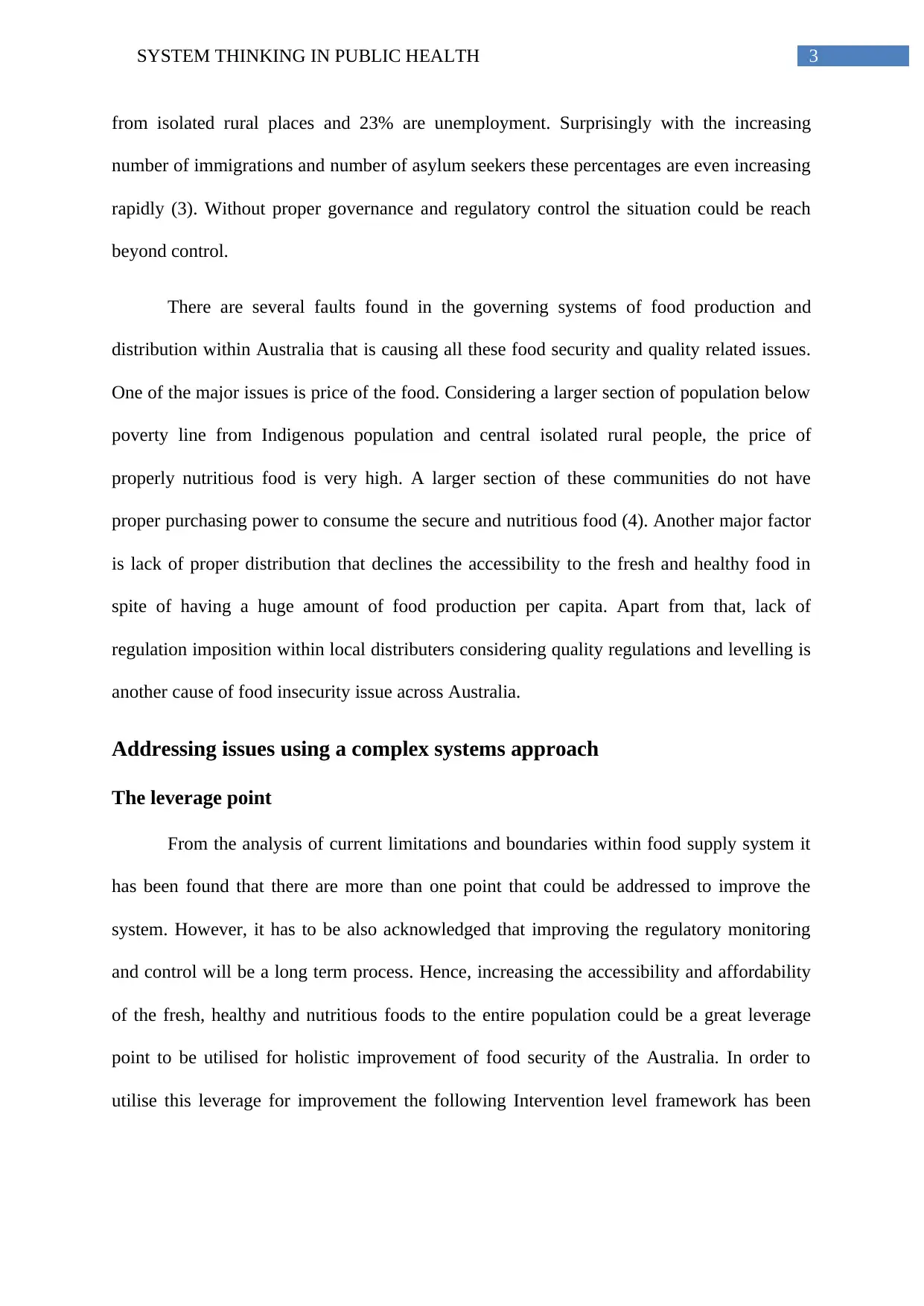
3SYSTEM THINKING IN PUBLIC HEALTH
from isolated rural places and 23% are unemployment. Surprisingly with the increasing
number of immigrations and number of asylum seekers these percentages are even increasing
rapidly (3). Without proper governance and regulatory control the situation could be reach
beyond control.
There are several faults found in the governing systems of food production and
distribution within Australia that is causing all these food security and quality related issues.
One of the major issues is price of the food. Considering a larger section of population below
poverty line from Indigenous population and central isolated rural people, the price of
properly nutritious food is very high. A larger section of these communities do not have
proper purchasing power to consume the secure and nutritious food (4). Another major factor
is lack of proper distribution that declines the accessibility to the fresh and healthy food in
spite of having a huge amount of food production per capita. Apart from that, lack of
regulation imposition within local distributers considering quality regulations and levelling is
another cause of food insecurity issue across Australia.
Addressing issues using a complex systems approach
The leverage point
From the analysis of current limitations and boundaries within food supply system it
has been found that there are more than one point that could be addressed to improve the
system. However, it has to be also acknowledged that improving the regulatory monitoring
and control will be a long term process. Hence, increasing the accessibility and affordability
of the fresh, healthy and nutritious foods to the entire population could be a great leverage
point to be utilised for holistic improvement of food security of the Australia. In order to
utilise this leverage for improvement the following Intervention level framework has been
from isolated rural places and 23% are unemployment. Surprisingly with the increasing
number of immigrations and number of asylum seekers these percentages are even increasing
rapidly (3). Without proper governance and regulatory control the situation could be reach
beyond control.
There are several faults found in the governing systems of food production and
distribution within Australia that is causing all these food security and quality related issues.
One of the major issues is price of the food. Considering a larger section of population below
poverty line from Indigenous population and central isolated rural people, the price of
properly nutritious food is very high. A larger section of these communities do not have
proper purchasing power to consume the secure and nutritious food (4). Another major factor
is lack of proper distribution that declines the accessibility to the fresh and healthy food in
spite of having a huge amount of food production per capita. Apart from that, lack of
regulation imposition within local distributers considering quality regulations and levelling is
another cause of food insecurity issue across Australia.
Addressing issues using a complex systems approach
The leverage point
From the analysis of current limitations and boundaries within food supply system it
has been found that there are more than one point that could be addressed to improve the
system. However, it has to be also acknowledged that improving the regulatory monitoring
and control will be a long term process. Hence, increasing the accessibility and affordability
of the fresh, healthy and nutritious foods to the entire population could be a great leverage
point to be utilised for holistic improvement of food security of the Australia. In order to
utilise this leverage for improvement the following Intervention level framework has been
Paraphrase This Document
Need a fresh take? Get an instant paraphrase of this document with our AI Paraphraser
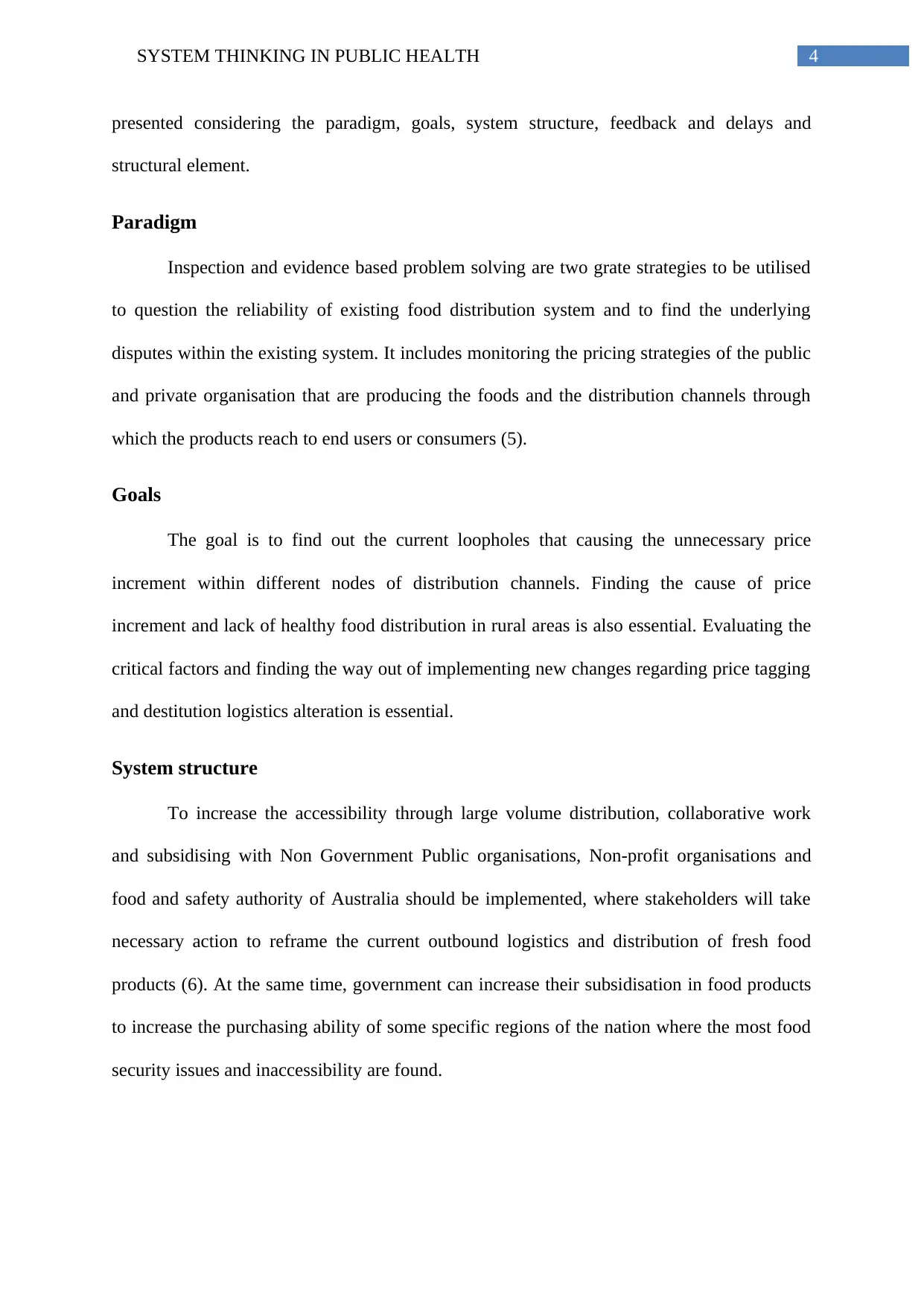
4SYSTEM THINKING IN PUBLIC HEALTH
presented considering the paradigm, goals, system structure, feedback and delays and
structural element.
Paradigm
Inspection and evidence based problem solving are two grate strategies to be utilised
to question the reliability of existing food distribution system and to find the underlying
disputes within the existing system. It includes monitoring the pricing strategies of the public
and private organisation that are producing the foods and the distribution channels through
which the products reach to end users or consumers (5).
Goals
The goal is to find out the current loopholes that causing the unnecessary price
increment within different nodes of distribution channels. Finding the cause of price
increment and lack of healthy food distribution in rural areas is also essential. Evaluating the
critical factors and finding the way out of implementing new changes regarding price tagging
and destitution logistics alteration is essential.
System structure
To increase the accessibility through large volume distribution, collaborative work
and subsidising with Non Government Public organisations, Non-profit organisations and
food and safety authority of Australia should be implemented, where stakeholders will take
necessary action to reframe the current outbound logistics and distribution of fresh food
products (6). At the same time, government can increase their subsidisation in food products
to increase the purchasing ability of some specific regions of the nation where the most food
security issues and inaccessibility are found.
presented considering the paradigm, goals, system structure, feedback and delays and
structural element.
Paradigm
Inspection and evidence based problem solving are two grate strategies to be utilised
to question the reliability of existing food distribution system and to find the underlying
disputes within the existing system. It includes monitoring the pricing strategies of the public
and private organisation that are producing the foods and the distribution channels through
which the products reach to end users or consumers (5).
Goals
The goal is to find out the current loopholes that causing the unnecessary price
increment within different nodes of distribution channels. Finding the cause of price
increment and lack of healthy food distribution in rural areas is also essential. Evaluating the
critical factors and finding the way out of implementing new changes regarding price tagging
and destitution logistics alteration is essential.
System structure
To increase the accessibility through large volume distribution, collaborative work
and subsidising with Non Government Public organisations, Non-profit organisations and
food and safety authority of Australia should be implemented, where stakeholders will take
necessary action to reframe the current outbound logistics and distribution of fresh food
products (6). At the same time, government can increase their subsidisation in food products
to increase the purchasing ability of some specific regions of the nation where the most food
security issues and inaccessibility are found.
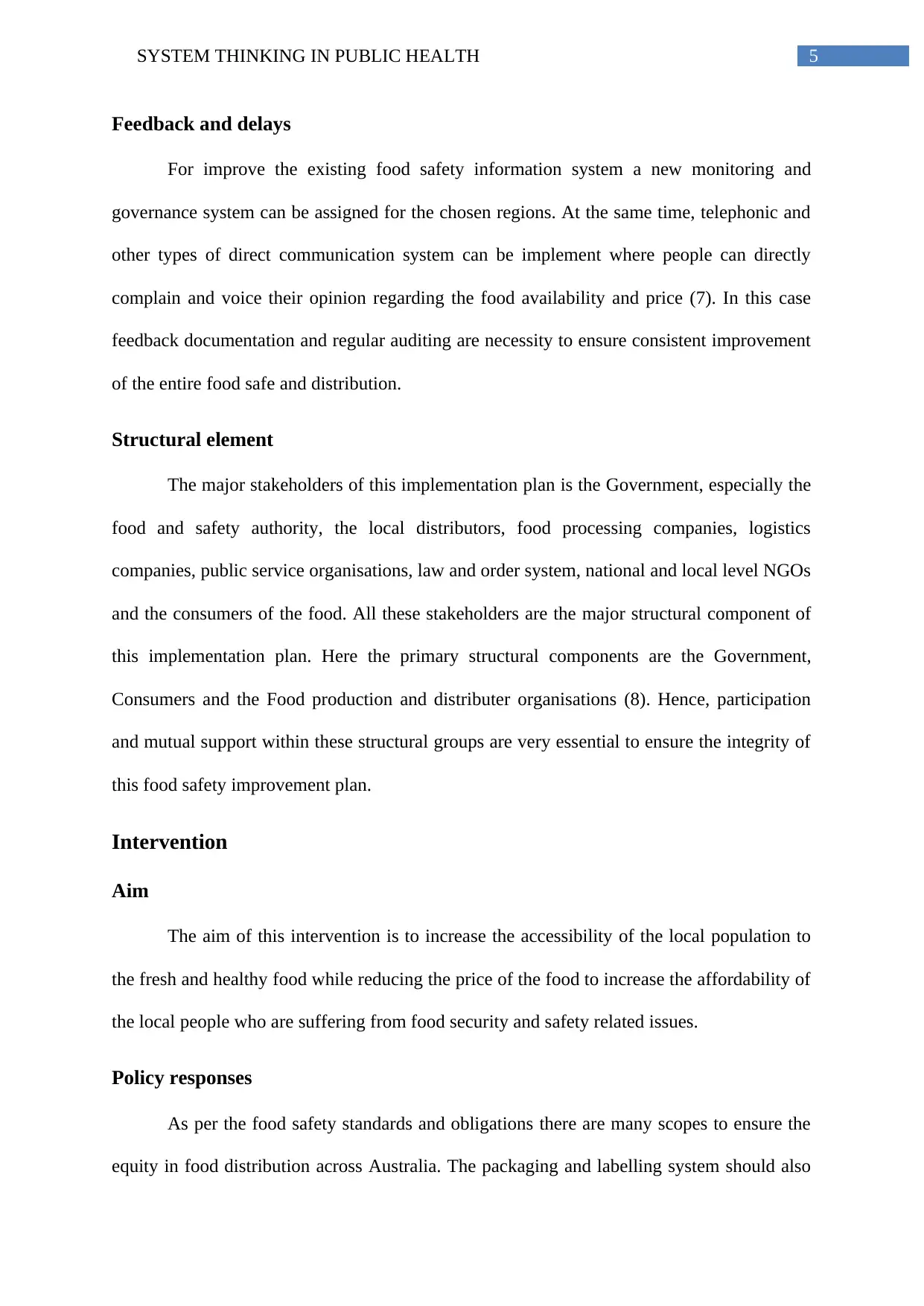
5SYSTEM THINKING IN PUBLIC HEALTH
Feedback and delays
For improve the existing food safety information system a new monitoring and
governance system can be assigned for the chosen regions. At the same time, telephonic and
other types of direct communication system can be implement where people can directly
complain and voice their opinion regarding the food availability and price (7). In this case
feedback documentation and regular auditing are necessity to ensure consistent improvement
of the entire food safe and distribution.
Structural element
The major stakeholders of this implementation plan is the Government, especially the
food and safety authority, the local distributors, food processing companies, logistics
companies, public service organisations, law and order system, national and local level NGOs
and the consumers of the food. All these stakeholders are the major structural component of
this implementation plan. Here the primary structural components are the Government,
Consumers and the Food production and distributer organisations (8). Hence, participation
and mutual support within these structural groups are very essential to ensure the integrity of
this food safety improvement plan.
Intervention
Aim
The aim of this intervention is to increase the accessibility of the local population to
the fresh and healthy food while reducing the price of the food to increase the affordability of
the local people who are suffering from food security and safety related issues.
Policy responses
As per the food safety standards and obligations there are many scopes to ensure the
equity in food distribution across Australia. The packaging and labelling system should also
Feedback and delays
For improve the existing food safety information system a new monitoring and
governance system can be assigned for the chosen regions. At the same time, telephonic and
other types of direct communication system can be implement where people can directly
complain and voice their opinion regarding the food availability and price (7). In this case
feedback documentation and regular auditing are necessity to ensure consistent improvement
of the entire food safe and distribution.
Structural element
The major stakeholders of this implementation plan is the Government, especially the
food and safety authority, the local distributors, food processing companies, logistics
companies, public service organisations, law and order system, national and local level NGOs
and the consumers of the food. All these stakeholders are the major structural component of
this implementation plan. Here the primary structural components are the Government,
Consumers and the Food production and distributer organisations (8). Hence, participation
and mutual support within these structural groups are very essential to ensure the integrity of
this food safety improvement plan.
Intervention
Aim
The aim of this intervention is to increase the accessibility of the local population to
the fresh and healthy food while reducing the price of the food to increase the affordability of
the local people who are suffering from food security and safety related issues.
Policy responses
As per the food safety standards and obligations there are many scopes to ensure the
equity in food distribution across Australia. The packaging and labelling system should also
⊘ This is a preview!⊘
Do you want full access?
Subscribe today to unlock all pages.

Trusted by 1+ million students worldwide
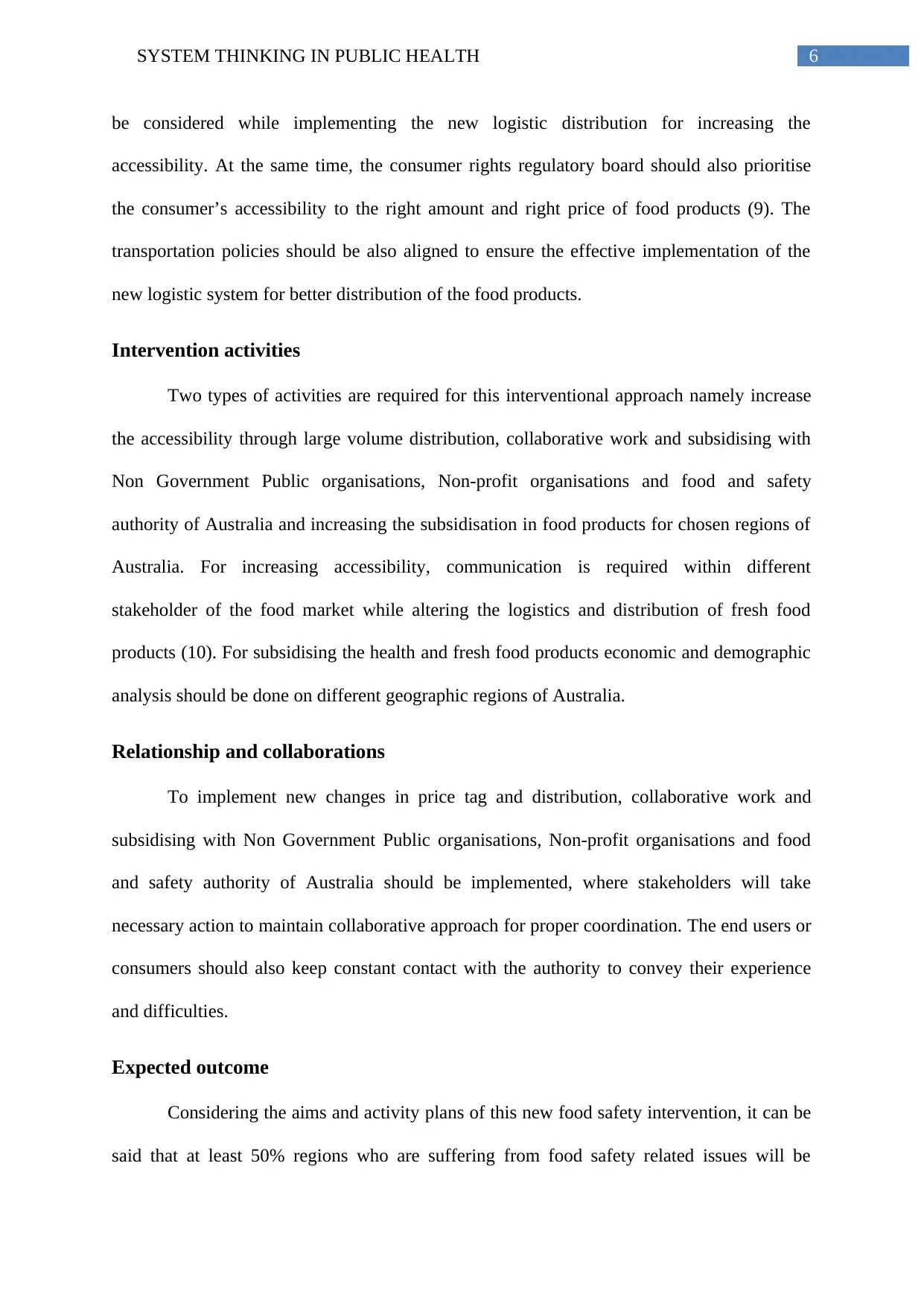
6SYSTEM THINKING IN PUBLIC HEALTH
be considered while implementing the new logistic distribution for increasing the
accessibility. At the same time, the consumer rights regulatory board should also prioritise
the consumer’s accessibility to the right amount and right price of food products (9). The
transportation policies should be also aligned to ensure the effective implementation of the
new logistic system for better distribution of the food products.
Intervention activities
Two types of activities are required for this interventional approach namely increase
the accessibility through large volume distribution, collaborative work and subsidising with
Non Government Public organisations, Non-profit organisations and food and safety
authority of Australia and increasing the subsidisation in food products for chosen regions of
Australia. For increasing accessibility, communication is required within different
stakeholder of the food market while altering the logistics and distribution of fresh food
products (10). For subsidising the health and fresh food products economic and demographic
analysis should be done on different geographic regions of Australia.
Relationship and collaborations
To implement new changes in price tag and distribution, collaborative work and
subsidising with Non Government Public organisations, Non-profit organisations and food
and safety authority of Australia should be implemented, where stakeholders will take
necessary action to maintain collaborative approach for proper coordination. The end users or
consumers should also keep constant contact with the authority to convey their experience
and difficulties.
Expected outcome
Considering the aims and activity plans of this new food safety intervention, it can be
said that at least 50% regions who are suffering from food safety related issues will be
be considered while implementing the new logistic distribution for increasing the
accessibility. At the same time, the consumer rights regulatory board should also prioritise
the consumer’s accessibility to the right amount and right price of food products (9). The
transportation policies should be also aligned to ensure the effective implementation of the
new logistic system for better distribution of the food products.
Intervention activities
Two types of activities are required for this interventional approach namely increase
the accessibility through large volume distribution, collaborative work and subsidising with
Non Government Public organisations, Non-profit organisations and food and safety
authority of Australia and increasing the subsidisation in food products for chosen regions of
Australia. For increasing accessibility, communication is required within different
stakeholder of the food market while altering the logistics and distribution of fresh food
products (10). For subsidising the health and fresh food products economic and demographic
analysis should be done on different geographic regions of Australia.
Relationship and collaborations
To implement new changes in price tag and distribution, collaborative work and
subsidising with Non Government Public organisations, Non-profit organisations and food
and safety authority of Australia should be implemented, where stakeholders will take
necessary action to maintain collaborative approach for proper coordination. The end users or
consumers should also keep constant contact with the authority to convey their experience
and difficulties.
Expected outcome
Considering the aims and activity plans of this new food safety intervention, it can be
said that at least 50% regions who are suffering from food safety related issues will be
Paraphrase This Document
Need a fresh take? Get an instant paraphrase of this document with our AI Paraphraser
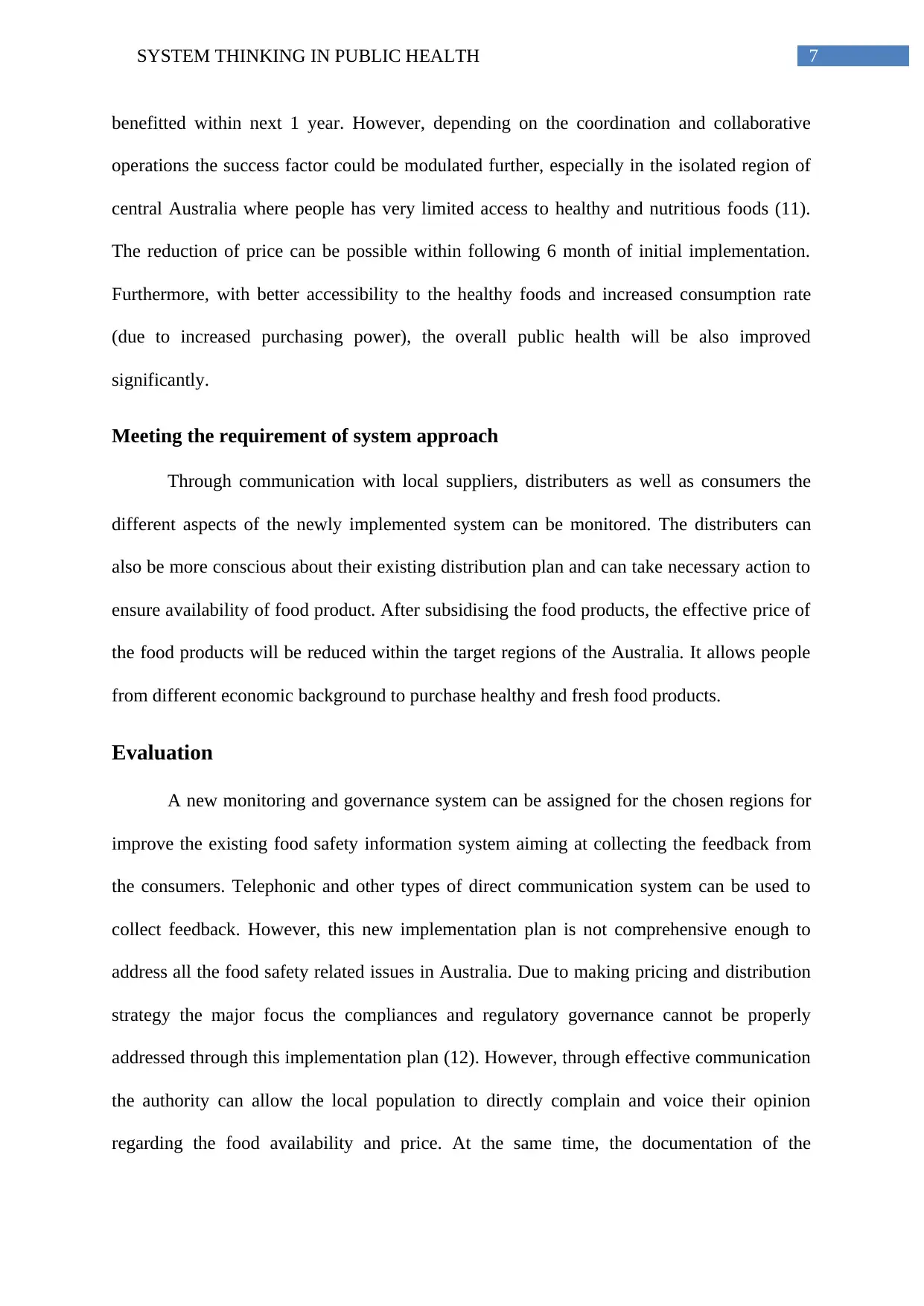
7SYSTEM THINKING IN PUBLIC HEALTH
benefitted within next 1 year. However, depending on the coordination and collaborative
operations the success factor could be modulated further, especially in the isolated region of
central Australia where people has very limited access to healthy and nutritious foods (11).
The reduction of price can be possible within following 6 month of initial implementation.
Furthermore, with better accessibility to the healthy foods and increased consumption rate
(due to increased purchasing power), the overall public health will be also improved
significantly.
Meeting the requirement of system approach
Through communication with local suppliers, distributers as well as consumers the
different aspects of the newly implemented system can be monitored. The distributers can
also be more conscious about their existing distribution plan and can take necessary action to
ensure availability of food product. After subsidising the food products, the effective price of
the food products will be reduced within the target regions of the Australia. It allows people
from different economic background to purchase healthy and fresh food products.
Evaluation
A new monitoring and governance system can be assigned for the chosen regions for
improve the existing food safety information system aiming at collecting the feedback from
the consumers. Telephonic and other types of direct communication system can be used to
collect feedback. However, this new implementation plan is not comprehensive enough to
address all the food safety related issues in Australia. Due to making pricing and distribution
strategy the major focus the compliances and regulatory governance cannot be properly
addressed through this implementation plan (12). However, through effective communication
the authority can allow the local population to directly complain and voice their opinion
regarding the food availability and price. At the same time, the documentation of the
benefitted within next 1 year. However, depending on the coordination and collaborative
operations the success factor could be modulated further, especially in the isolated region of
central Australia where people has very limited access to healthy and nutritious foods (11).
The reduction of price can be possible within following 6 month of initial implementation.
Furthermore, with better accessibility to the healthy foods and increased consumption rate
(due to increased purchasing power), the overall public health will be also improved
significantly.
Meeting the requirement of system approach
Through communication with local suppliers, distributers as well as consumers the
different aspects of the newly implemented system can be monitored. The distributers can
also be more conscious about their existing distribution plan and can take necessary action to
ensure availability of food product. After subsidising the food products, the effective price of
the food products will be reduced within the target regions of the Australia. It allows people
from different economic background to purchase healthy and fresh food products.
Evaluation
A new monitoring and governance system can be assigned for the chosen regions for
improve the existing food safety information system aiming at collecting the feedback from
the consumers. Telephonic and other types of direct communication system can be used to
collect feedback. However, this new implementation plan is not comprehensive enough to
address all the food safety related issues in Australia. Due to making pricing and distribution
strategy the major focus the compliances and regulatory governance cannot be properly
addressed through this implementation plan (12). However, through effective communication
the authority can allow the local population to directly complain and voice their opinion
regarding the food availability and price. At the same time, the documentation of the
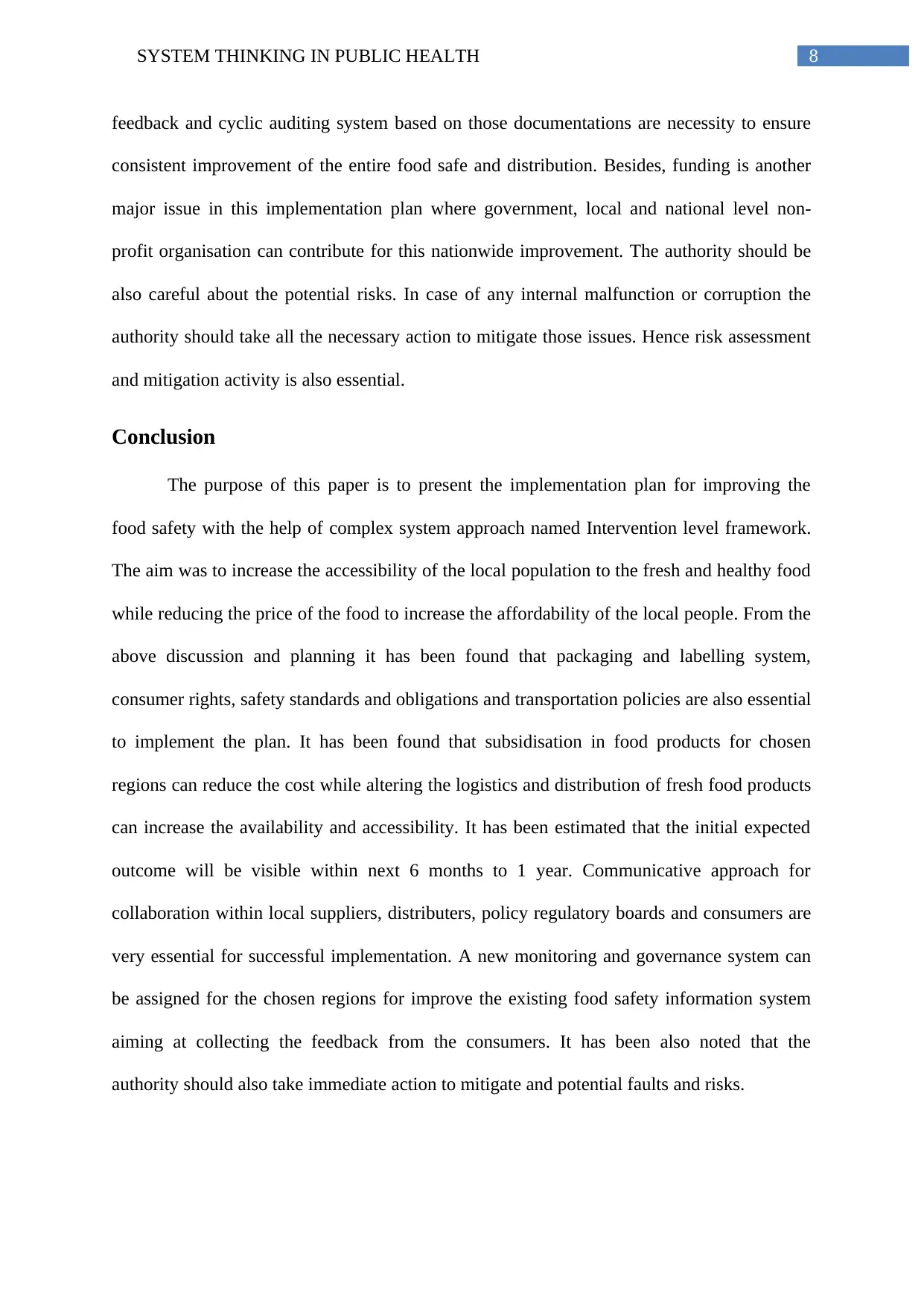
8SYSTEM THINKING IN PUBLIC HEALTH
feedback and cyclic auditing system based on those documentations are necessity to ensure
consistent improvement of the entire food safe and distribution. Besides, funding is another
major issue in this implementation plan where government, local and national level non-
profit organisation can contribute for this nationwide improvement. The authority should be
also careful about the potential risks. In case of any internal malfunction or corruption the
authority should take all the necessary action to mitigate those issues. Hence risk assessment
and mitigation activity is also essential.
Conclusion
The purpose of this paper is to present the implementation plan for improving the
food safety with the help of complex system approach named Intervention level framework.
The aim was to increase the accessibility of the local population to the fresh and healthy food
while reducing the price of the food to increase the affordability of the local people. From the
above discussion and planning it has been found that packaging and labelling system,
consumer rights, safety standards and obligations and transportation policies are also essential
to implement the plan. It has been found that subsidisation in food products for chosen
regions can reduce the cost while altering the logistics and distribution of fresh food products
can increase the availability and accessibility. It has been estimated that the initial expected
outcome will be visible within next 6 months to 1 year. Communicative approach for
collaboration within local suppliers, distributers, policy regulatory boards and consumers are
very essential for successful implementation. A new monitoring and governance system can
be assigned for the chosen regions for improve the existing food safety information system
aiming at collecting the feedback from the consumers. It has been also noted that the
authority should also take immediate action to mitigate and potential faults and risks.
feedback and cyclic auditing system based on those documentations are necessity to ensure
consistent improvement of the entire food safe and distribution. Besides, funding is another
major issue in this implementation plan where government, local and national level non-
profit organisation can contribute for this nationwide improvement. The authority should be
also careful about the potential risks. In case of any internal malfunction or corruption the
authority should take all the necessary action to mitigate those issues. Hence risk assessment
and mitigation activity is also essential.
Conclusion
The purpose of this paper is to present the implementation plan for improving the
food safety with the help of complex system approach named Intervention level framework.
The aim was to increase the accessibility of the local population to the fresh and healthy food
while reducing the price of the food to increase the affordability of the local people. From the
above discussion and planning it has been found that packaging and labelling system,
consumer rights, safety standards and obligations and transportation policies are also essential
to implement the plan. It has been found that subsidisation in food products for chosen
regions can reduce the cost while altering the logistics and distribution of fresh food products
can increase the availability and accessibility. It has been estimated that the initial expected
outcome will be visible within next 6 months to 1 year. Communicative approach for
collaboration within local suppliers, distributers, policy regulatory boards and consumers are
very essential for successful implementation. A new monitoring and governance system can
be assigned for the chosen regions for improve the existing food safety information system
aiming at collecting the feedback from the consumers. It has been also noted that the
authority should also take immediate action to mitigate and potential faults and risks.
⊘ This is a preview!⊘
Do you want full access?
Subscribe today to unlock all pages.

Trusted by 1+ million students worldwide
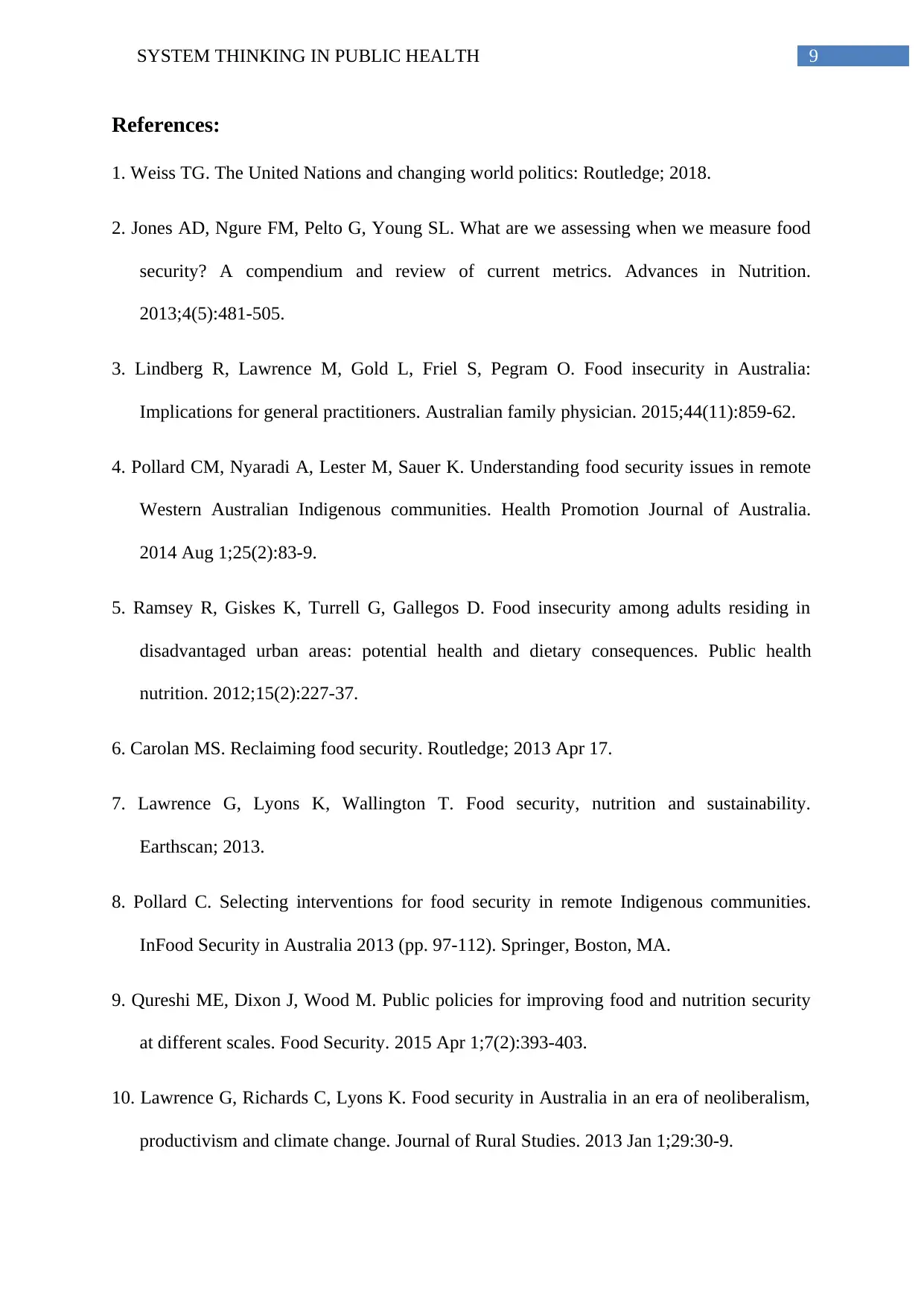
9SYSTEM THINKING IN PUBLIC HEALTH
References:
1. Weiss TG. The United Nations and changing world politics: Routledge; 2018.
2. Jones AD, Ngure FM, Pelto G, Young SL. What are we assessing when we measure food
security? A compendium and review of current metrics. Advances in Nutrition.
2013;4(5):481-505.
3. Lindberg R, Lawrence M, Gold L, Friel S, Pegram O. Food insecurity in Australia:
Implications for general practitioners. Australian family physician. 2015;44(11):859-62.
4. Pollard CM, Nyaradi A, Lester M, Sauer K. Understanding food security issues in remote
Western Australian Indigenous communities. Health Promotion Journal of Australia.
2014 Aug 1;25(2):83-9.
5. Ramsey R, Giskes K, Turrell G, Gallegos D. Food insecurity among adults residing in
disadvantaged urban areas: potential health and dietary consequences. Public health
nutrition. 2012;15(2):227-37.
6. Carolan MS. Reclaiming food security. Routledge; 2013 Apr 17.
7. Lawrence G, Lyons K, Wallington T. Food security, nutrition and sustainability.
Earthscan; 2013.
8. Pollard C. Selecting interventions for food security in remote Indigenous communities.
InFood Security in Australia 2013 (pp. 97-112). Springer, Boston, MA.
9. Qureshi ME, Dixon J, Wood M. Public policies for improving food and nutrition security
at different scales. Food Security. 2015 Apr 1;7(2):393-403.
10. Lawrence G, Richards C, Lyons K. Food security in Australia in an era of neoliberalism,
productivism and climate change. Journal of Rural Studies. 2013 Jan 1;29:30-9.
References:
1. Weiss TG. The United Nations and changing world politics: Routledge; 2018.
2. Jones AD, Ngure FM, Pelto G, Young SL. What are we assessing when we measure food
security? A compendium and review of current metrics. Advances in Nutrition.
2013;4(5):481-505.
3. Lindberg R, Lawrence M, Gold L, Friel S, Pegram O. Food insecurity in Australia:
Implications for general practitioners. Australian family physician. 2015;44(11):859-62.
4. Pollard CM, Nyaradi A, Lester M, Sauer K. Understanding food security issues in remote
Western Australian Indigenous communities. Health Promotion Journal of Australia.
2014 Aug 1;25(2):83-9.
5. Ramsey R, Giskes K, Turrell G, Gallegos D. Food insecurity among adults residing in
disadvantaged urban areas: potential health and dietary consequences. Public health
nutrition. 2012;15(2):227-37.
6. Carolan MS. Reclaiming food security. Routledge; 2013 Apr 17.
7. Lawrence G, Lyons K, Wallington T. Food security, nutrition and sustainability.
Earthscan; 2013.
8. Pollard C. Selecting interventions for food security in remote Indigenous communities.
InFood Security in Australia 2013 (pp. 97-112). Springer, Boston, MA.
9. Qureshi ME, Dixon J, Wood M. Public policies for improving food and nutrition security
at different scales. Food Security. 2015 Apr 1;7(2):393-403.
10. Lawrence G, Richards C, Lyons K. Food security in Australia in an era of neoliberalism,
productivism and climate change. Journal of Rural Studies. 2013 Jan 1;29:30-9.
Paraphrase This Document
Need a fresh take? Get an instant paraphrase of this document with our AI Paraphraser

10SYSTEM THINKING IN PUBLIC HEALTH
11. King T, Cole M, Farber JM, Eisenbrand G, Zabaras D, Fox EM, Hill JP. Food safety for
food security: Relationship between global megatrends and developments in food safety.
Trends in Food Science & Technology. 2017 Oct 1;68:160-75.
12. Augustin MA, Riley M, Stockmann R, Bennett L, Kahl A, Lockett T, Osmond M,
Sanguansri P, Stonehouse W, Zajac I, Cobiac L. Role of food processing in food and
nutrition security. Trends in Food Science & Technology. 2016 Oct 1;56:115-25.
11. King T, Cole M, Farber JM, Eisenbrand G, Zabaras D, Fox EM, Hill JP. Food safety for
food security: Relationship between global megatrends and developments in food safety.
Trends in Food Science & Technology. 2017 Oct 1;68:160-75.
12. Augustin MA, Riley M, Stockmann R, Bennett L, Kahl A, Lockett T, Osmond M,
Sanguansri P, Stonehouse W, Zajac I, Cobiac L. Role of food processing in food and
nutrition security. Trends in Food Science & Technology. 2016 Oct 1;56:115-25.
1 out of 11
Related Documents
Your All-in-One AI-Powered Toolkit for Academic Success.
+13062052269
info@desklib.com
Available 24*7 on WhatsApp / Email
![[object Object]](/_next/static/media/star-bottom.7253800d.svg)
Unlock your academic potential
© 2024 | Zucol Services PVT LTD | All rights reserved.





